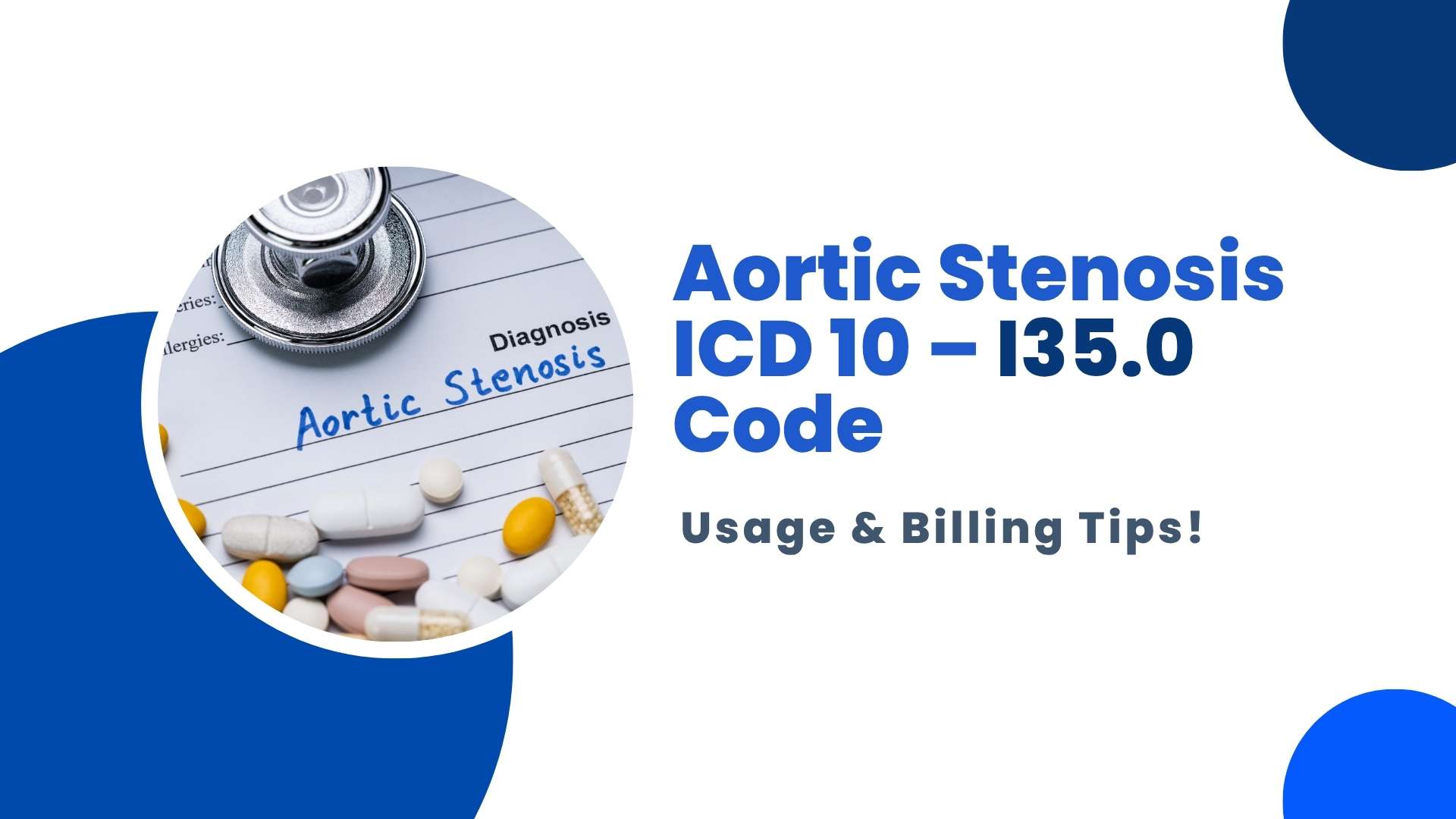Heart problems are common nowadays, and even young people are affected. Among the few most prevalent heart problems, Aortic valve stenosis is one of the most common. If it happens, the patient’s aortic valve becomes too narrow.
Due to its narrowness, blood flow is disturbed, making it difficult for blood to flow out of the heart. It can become a serious heart health issue if not treated in a timely manner. However, in the medical field, it is indicated by an ICD-10 code I35.0.
In this article series, we will thoroughly examine what Aortic Stenosis ICD-10 is all about and how to avoid professional challenges when using this code, as incorrect information may hinder your purpose when it comes time for payouts.
What is Aortic Stenosis?
Aortic valve stenosis signifies the narrowing of the aortic valve within the heart. This constriction limits the amount of blood which can pass to and from it, and may give rise to several symptoms such as:
- Chest pain
- Shortness of breath
- Syncope
If the problem is not treated in a timely manner, it can cause heart failure. It can be a mild, moderate, or even, in some cases, severe heart failure that may lead to death. Usually, seniors face this heart problem due to valve sclerosis. However, rheumatic fever is also a contributing factor.
Whatever the cause, the best thing is its accurate identification and correct use on the medical bills. It helps to choose the proper treatment and prevent delays.
What Code is used in the ICD-10-CM System for Aortic Stenosis?
In medical billing, the I35.0 code refers to aortic stenosis, which is not caused by rheumatic fever. This can happen when the aortic valve becomes stiff and narrow due to calcification or sclerosis. It impedes the flow of blood from the heart. This code is applied by medical professionals whenever the disease occurs, regardless of whether it is associated with rheumatic fever.
It also helps care managers to track and treat heart valve problems correctly. Many of these non-rheumatic aortic stenosis codes appear in ICD-10, but I35.0 is the one that indicates the disease without any link to rheumatic disease, whatever.
The proper code on a medical record ensures that data is accurate, records are delivered in an organised manner, and the patient receives what they need. It also prevents confusion with diseases resulting from rheumatic fever, which carry their own diseases and require different treatments.
Other ICD-10 Codes for Aortic Stenosis and Valve Disease
The non-rheumatic aortic valve calcification must be entered under code I35.0. Archive document codes for this and other similar conditions include 135.1 for non-rheumatic aortic insufficiency; 135.8 for aortic sclerosis; and 135.9 for unspecified aortic valve disorder.
Occasionally, an accompanying code is needed for non-rheumatic aortic stenosis in conjunction with other valve problems. When it becomes severe, aortic stenosis calls for treatment to avoid life-threatening complications. Usually, this means surgical valve replacement.
This code enables better heart valve care and management by allowing for the accurate recording of valve conditions. These codes enable doctors to better plan treatment for a person with one or more heart disease conditions. In most cases, this avoids major complications from surgery.
When entering an ICD-10 code for aortic valve stenosis, it must be accompanied by messages related to aortic valve replacement. Doctors use certain codes for aortic valve surgeries. Code Z95.2 means the person has an artificial aortic valve. Code 02RF0JZ is used when that valve is replaced with a synthetic one.
These codes help indicate the type of treatment performed and whether any follow-up issues arose. They’re also important for billing and maintaining accurate medical records. Using the correct code makes sure both doctors and insurance understand the complete picture of the treatment.
When to Use I35.0 Documentation?
The I35.0 code should be used only if the diagnosis specifically states nonrheumatic aortic valve stenosis. If a patient has aortic sclerosis or calcification without a rheumatic cause, use code I35.0. However, if the doctor attributes the condition to rheumatic fever, then use a code from the I06 series. These are for rheumatic heart disease. The records must mention the cause. Proper notes help pick the correct code. If it’s not rheumatic, ensure that this is clearly stated to support the use of I35.0 in the report.
Helpful Tips for Billing for I35.0
Everyone wants accuracy for correct treatment and smooth claim processing. Here, we provide some practical tips to ensure maximum accuracy.
- Confirm Nonrheumatic Origin: When assigning I35.0 code, ensure the problem is non-rheumatic. If not, then do not use that code.
- Specify Severity: Clear details in records make a big difference in patient care and insurance processing. So, ensure the severity of the problem is included in the document.
- Document Symptoms and Complications: For the correct billing code, it is also essential to include the symptoms of the problems. You may need to include possible symptoms like angina, dyspnea, or syncope.
- Use Procedural Codes for Surgeries: If a patient undergoes surgery, such as valve replacement or a balloon procedure, ensure that ICD-10-CM code 35.0 is added with the corresponding procedure codes. This helps show exactly what was wrong and what treatment was done in the records.
Cardiac conditions like aortic stenosis can sometimes be worsened by electrolyte imbalances. For guidance on coding such deficiencies, see our billing guide for hypomagnesemia, ICD-10 code E83.42.
Documentation Checklist
Is your document ready? It’s good, but it is better to check and ensure all essential things are included to prevent rejection. Here is the list of things to check for:
✅ Diagnosis of non-rheumatic aortic valve stenosis is confirmed.
✅ Ensure the severity of the problem is mentioned in the document.
✅ Make sure all findings are included in the document, such as showing clarification about sclerosis of the valve.
✅ Also, check that the symptoms, such as chest pain or heart murmur, are included.
✅Intervene in such pain. Whether the valve should be rein and, if so, when monitoring might take place, all of this needs to be documented.
The initial input of data sometimes causes healthcare coding errors; the nature of human error is that it always occurs. But with a bit of care, the chances of error can be minimized.
Final Words
The patient, doctor, and medical billing staff need to understand the codes. It prevents delays in treatment, billing, and claims. Using the correct ICD-10 codes ensures a smooth process. In medical billing, the I35.0 code is used for aortic valve issues.
However, other codes are also used. Knowing these codes can help you receive better treatment. A wrong code can affect you in many ways, especially if it results in delayed treatment.
If you need assistance with billing, Providers Care Billing LLC is the best supporting service for you. From the initial visit to getting the claim, they will support you at every point.




